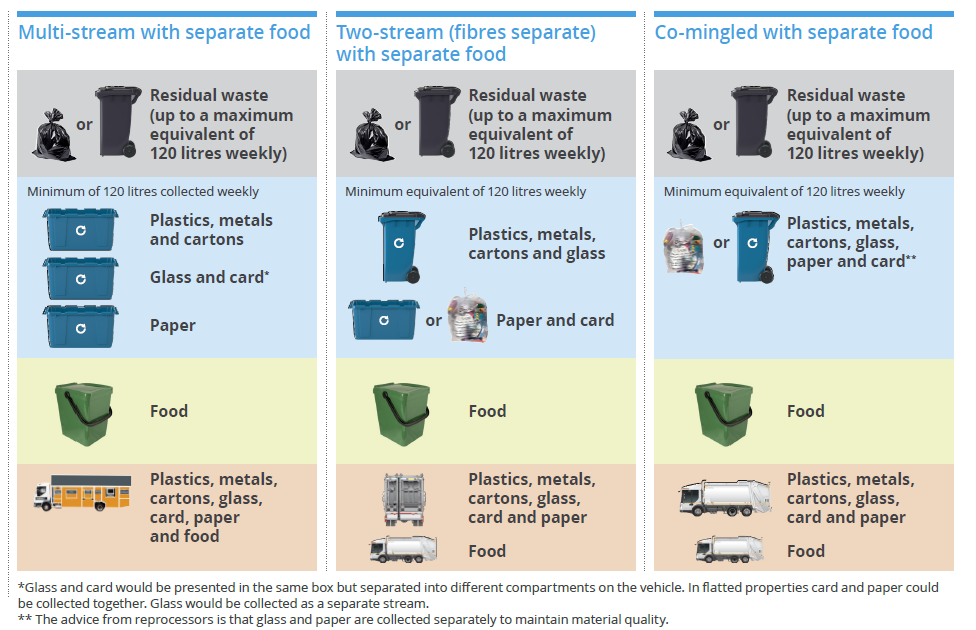Collection System Design: Difference between revisions
m Dry Recyclables link |
expanded text |
||
| Line 1: | Line 1: | ||
== Behaviour == | |||
The size of the bin given to householders for [[Residual Waste]] and the frequency with which it is emptied can also vary according to the behavioural change being targeted by the relevant [[Waste Collection Authority]]. By constraining the capacity of the [[Residual Waste]] container issued to its residents the more the resident is 'pushed' into increasing the items for recycling. | The size of the bin given to householders for [[Residual Waste]] and the frequency with which it is emptied can also vary according to the behavioural change being targeted by the relevant [[Waste Collection Authority]]. By constraining the capacity of the [[Residual Waste]] container issued to its residents the more the resident is 'pushed' into increasing the items for recycling. | ||
| Line 7: | Line 7: | ||
Whatever the size of the bin chosen by the [[Waste Collection Authority]] for [[Residual Waste]] it must do so in tandem with more frequent collection of [[Food Waste]] and [[Dry Recyclables]] to compensate for the reduced capacity. | Whatever the size of the bin chosen by the [[Waste Collection Authority]] for [[Residual Waste]] it must do so in tandem with more frequent collection of [[Food Waste]] and [[Dry Recyclables]] to compensate for the reduced capacity. | ||
[[Category:Arrangements]] | [[Category:Arrangements]] | ||
== Charging for Service == | |||
The collection of waste and recyclables from residents is a legal requirement and no charge can be made for this service. The exceptions are those materials that are not defined in the legislation, and this includes Green Waste collection. | |||
== Service Structure/Combination == | |||
[[WRAP]] in their report on greater consistency<ref>[http://static.wrap.org.uk/consistancy/Read_more_about_the_framework.pdf Link to report and content on WRAP website]</ref> proposed the following default approaches to Collection System Design, although the number of systems presently in use show little sign of aligininig with these default options: | |||
[[File:WRAP Framework for greater consistency.png|frame|center|Summary Default Options for Collection System Design Proposed by WRAP]] | |||
== References == | |||
Revision as of 14:38, 15 November 2019
Behaviour
The size of the bin given to householders for Residual Waste and the frequency with which it is emptied can also vary according to the behavioural change being targeted by the relevant Waste Collection Authority. By constraining the capacity of the Residual Waste container issued to its residents the more the resident is 'pushed' into increasing the items for recycling.
For instance a Waste Collection Authority may choose to issue a smaller bin to residents restrict Residual Waste or it may supply a slightly larger bin that is collected less frequently. The other option available to the Waste Collection Authority is to issue its residents with both a smaller bin that is also collected less frequently.
Whatever the size of the bin chosen by the Waste Collection Authority for Residual Waste it must do so in tandem with more frequent collection of Food Waste and Dry Recyclables to compensate for the reduced capacity.
Charging for Service
The collection of waste and recyclables from residents is a legal requirement and no charge can be made for this service. The exceptions are those materials that are not defined in the legislation, and this includes Green Waste collection.
Service Structure/Combination
WRAP in their report on greater consistency[1] proposed the following default approaches to Collection System Design, although the number of systems presently in use show little sign of aligininig with these default options:

